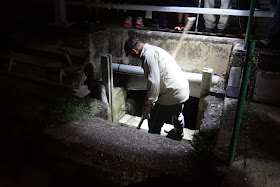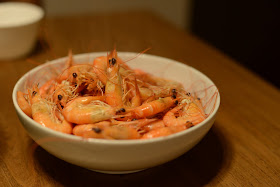It's probably the first time I set foot in the Mai Po Marshes since I was a kid, but last weekend we went on an evening tour of this protected nature reserve in the northwest tip of Hong Kong adjacent to the mainland China border, and in particular, to observe the traditional practice of harvesting Gei Wai shrimps there.

Mai Po Nature Reserve, managed by the Non-Governmental Organization WWF Hong Kong, is best known as the resting haven for migratory birds, and hence a famous spot for bird-watchers worldwide. It's said during the spring and autumn seasons, thousands of birds, including some of the endangered species, made their stops in Mai Po as they moved between north and south, as the wetland provided the perfect feeding and resting ground for them midway through their flight route. The unique geography of tidal marshes and mangroves with proximity to the river delta also made Mai Po one of the few remaining areas for the local fish farm industry for a number of fish and shrimps, known as "Gei Wai shrimps" (基圍蝦), so named as they were farmed in
Gei Wai (基圍), a man-made dyke between the ocean and the mangroves in which shrimps were raised and harvested.
 |
| Gei Wai Shrimps |
Once a popular farming practice supplying locals with this delicacy shrimps on our dining tables, at present only a handful of
gei wai remains because of continuous urban sprawl, with most of them within Mai Po Nature Reserve, operated not for commercial use but as a way to showcase this sustainable technique, which balanced productivity with minimal disruption to natural landscape and wildlife habitat.
 |
| Mai Po Nature Reserve Visitor Center |
Our visit was actually an educational tour organized by WWF Hong Kong every year during the summer shrimp harvest season. The tour began just before sunset at the Visitor Center near the entrance of the reserve, where the guide gave us a 30-minute overview of Mai Po and the conservation effort for this treasured land.
 |
| Restricted Area - Require Entry Permit to enter the nature reserve area |
 |
| The wetland where crabs and mudskippers reside (with the city of Shenzhen in the background north of Hong Kong border) |
 |
| Fruit (I believe it's Longan) which local villagers planted in their farm |
Then along with the guide, our tour group of 20-something people made a slow stroll along the narrow path through the rural villages into the restricted nature reserve area, and we were introduced to many plant and animal species spotted on the way, whether that be from the nature or grown by farmers who still lived in those villages.
 |
| Guide explaining the shrimp harvesting history and process |
 |
| Next to the gei wai was a "museum" showcasing some of the traditional fishing tools being used - those little net on the right was for catching mudskippers which would bounce around in the mudflat and got trapped in the net |
Of course, the highlight of the tour was the visit to
gei wai, one of the 24 located in Mai Po nowadays, and a presentation and demonstration of how the traditional shrimp harvesting works. As mentioned, each gei wai is a set of rectangular "pond" surrounded by raised dykes in the mangroves with a sluice gate separated the pond from the sea to control the water level. During winter high-tide months, the gate will be opened temporarily allowing brackish water (sea water which was diluted by the freshwater flowing from the nearby Shenzhen River) and the baby shrimps to be flushed into the pond. For the next few months, the gate would remain closed while the shrimps would be raised and feed on natural habitat in the mangrove.
 |
| Opening the Sluice Gate |
 |
| Removing the net filled with shrimps |
Grown shrimps can then be harvested from late spring and throughout the summer, usually at night when the tide is low and the shrimps were the most active (this is why our tour didn't start until sunset). At harvest, the worker would place a net at the sluice gate before the gate was manually raised. The low tide would flush the water out from the pond seaward through the gate and shrimps (along with other fish that might reside in the pond) would be caught in the net. Each year, each
gei wai could be harvested up to 80 times, as explained by our guide. At the end of summer, the pond will be completely drained, and the remaining fish and other ocean species would become food for the birds who happened to fly by. So it's a win-win situation between human and wildlife - shrimps for us, free meal for the birds - all the while the impact on the natural environment was kept to a minimum.
 |
| Picking shrimps! |
And on top of being able to observe up close how shrimps were harvested, the best part of the tour (or for some, perhaps the only purpose) was each of us could get to pick our own shrimps from the catch towards the end and brought them home for consumption! Not a lot really - just a small bucket-ful each - but definitely plenty for one to two meals.
 |
| The shrimps may be a little smaller than the ones we usually saw in the market (most likely coming from a large-scale fish farms in China), but the taste and texture were not even in the same league. The best we have had for a long long while. |
 |
| Souemon Junmai Daiginjo from Nakamura Brewery in Yamagata Prefecture (made from 100% aiyamamai with polishing ratio of 40%) (惣右衛門 純米大吟醸 愛山 - 山形県長沼合名会社) |
Once we got home, we spared no time turning those freshly-caught shrimps into a feast. Gei wai shrimps were well-known for its thin shells (because of its unique brackish water habitat), almost sweet taste and bouncy texture when cooked. With such fresh produce in hand, you really just want to cook without much intervention to the original flavors. Just give them a quick rinse, throw them into boiling water for a few minutes and that's really all you need.
When explaining the way to cook and eat the shrimps, the guide even discouraged us from dipping them into soy sauce as we would normally do - but I thought some light soy sauce definitely helped to enhance the umami taste. We even kept the shells - those would make a great broth for bisque or a bowl of wonton noodle soup.
And we just happened to have the perfect wine too - a bottle of junmai daiginjo we brought back from Japan - well chilled and ready in the fridge. So we just ended our meaningful evening on a high note with a late dinner with nothing but the shrimps, paired with the wonderful sake.
Additional Information:
Mai Po Overview:
World Wildlife Fund Hong Kong;
Wikipedia;
Hong Kong Government
Visitor Information:
http://www.wwf.org.hk/en/getinvolved/gomaipo/
Sidenote: Since the area is restricted, the best way to visit is through the guided tour organized by WWF. While tours are available year-round, the shrimp harvesting tour is only available during summer months and tend to be filled up rather quickly. We booked ours months in advance at the recommendation of our friends who went with us.
 |
| Exact location of Mai Po Nature Reserve (source: Google Map) |

















No comments :
Post a Comment